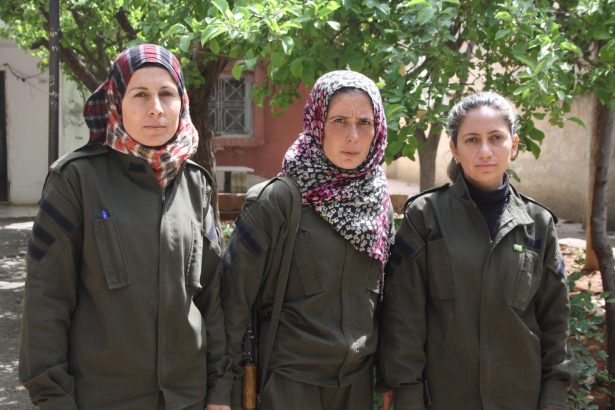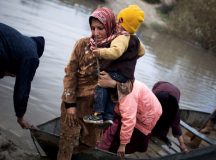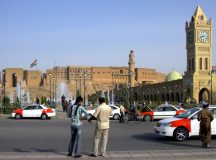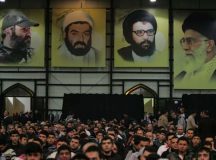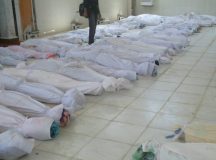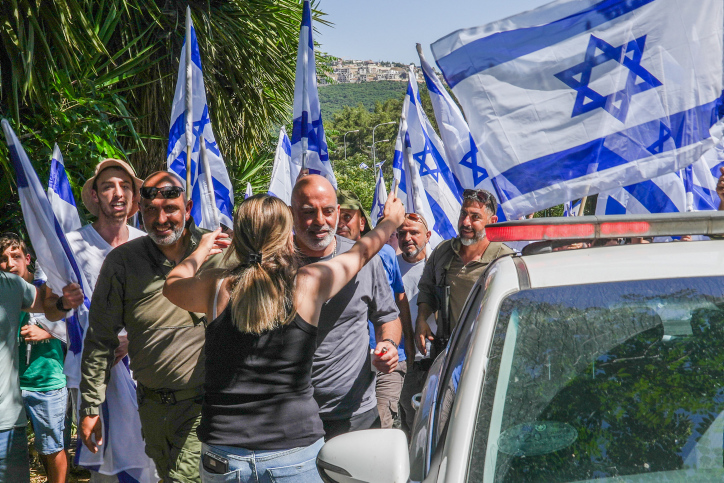Jonathan Spyer is one of the few policy experts to regularly visit the front lines in Syria. In this article, he maps the state of the conflict today and the character of the forces waging it. He argues there is no longer a single ‘civil war’ between a regime and a rebellion, but a vicious and chaotic battle between a variety of powerful entities, each strong enough to prevent its destruction by any of the others, promising only continued war and the further fragmentation of the country.
The Syrian Civil War is now grinding on into its fourth year. Over 150,000 people have died, and tens more are being killed every day in the ongoing fighting. Millions have lost their homes. Many will almost certainly never return to them. This is by far the greatest disaster to have hit the Levant in a generation. It has impacted not only Syria itself, but also its neighbours – with most profound implications for Iraq and Lebanon.
Syria today has in many ways ceased to exist as a coherent entity. Since mid-2012, the regime of Bashar Assad has ruled over only a minority of the territory of the country (about 40 per cent) and a bare majority of its population. No united successor regime has arisen in the area not controlled by the regime. Rather, a number of projects are under way.
Perhaps the most powerful and consequential of these is the Islamic proto-state controlled by the Islamic State in Iraq and Syria (ISIS) organisation, stretching from Anbar and Ninawah provinces in western Iraq, up through eastern Syria to the Turkish border.
A Kurdish autonomous project has also emerged, ruling over three non-contiguous areas of majority Kurdish population in northern Syria. Elsewhere, a variety of rival Sunni Arab rebel groups have carved out fiefdoms of their own. The country today is a confusing patchwork of rival powers. The regime possesses a coherent entity stretching from the capital, Damascus and its environs, up to the western coastal area – the heartland of the Alawi sect to which the president belongs.
The regime has won a series of victories in recent months, first of all in the Qalamun mountains area, culminating in the capture of the town of Rankous. Regime forces followed this by clearing out the city of Homs, part of which had been held by the rebels since the first year of the uprising.
These achievements on the part of the regime were impressive. They led to it feeling sufficiently confident to announce presidential ‘elections’ in June. Assad also issued a statement predicting that military operations by his armed forces would conclude in 2014, leaving only the fight against terrorism.
Assad’s renewed confidence appears somewhat misplaced, however. The dictator, with the very determined and consequential aid of the Iranian Revolutionary Guards Corps and various Iranian regional allies and proxies, has succeeded in ending any immediate danger to the regime’s existence. This is a not inconsiderable achievement, when one considers that, at the end of 2012, the rebels appeared set to conquer Aleppo and begin a push for Damascus. In 2013 the regime succeeded in reversing this picture.
Yet as of now, at least, what this seems to mean is the consolidation of the lines that fragment Syria, and which render its borders increasingly fictional. Assad may have ring-fenced the capital and the west, but he is not even close to achieving the reunification of the country. The same weaknesses that caused the regime to abandon large swathes of Syria in the summer of 2012 remain relevant: the shortage of reliable manpower, and the inability to take and hold areas of rebel support.
Consequently, the foreseeable future for Syria appears to offer only fragmentation and continued war. To understand Syria today, it is important to understand that there is no longer a single ‘civil war’ taking place between a regime and a rebellion against it. Rather, there exists a variety of powerful entities in the country, each strong enough to prevent its destruction by any of the others.
The Assad regime in mid-2014
The Assad regime should not be seen as a single, unified structure. ‘Regime’ forces today constitute a network of interests, not all of which are under the direct command of Assad himself. Indeed, the most significant element of the forces engaged on behalf of the regime – namely, the Iranian Revolutionary Guards Quds Force personnel and Hezbollah – do not take orders from the dictator.
Assad has from the outset enjoyed a very pronounced technical superiority over the rebels. He has maintained total control of the country’s skies. He possesses also a missile and artillery capability, and strong international backing – from Iran, Russia and Iraq – a level of support not enjoyed by the rebellion.
His problem from the outset, however, has been a lack of reliable manpower. While on paper, the Syrian Arab Army (SAA) is large – approximately 295,000 regular soldiers – the great majority of these were Sunni Arab conscripts whom the regime could not trust once the rebellion began.
Assad could rely only on a number of select units – his special forces, the Republican Guard, and the 4th Armoured Division commanded by his brother Maher. These were augmented by the largely Alawi irregular forces known as the Shabiha.
In the course of 2013, the problem of a lack of reliable manpower was to an extent solved by the arrival of greater numbers of foreign fighters and, no less importantly, by the creation and training by the Quds Force and Hezbollah of a new militia force, the National Defence Forces, which operates as an auxiliary force for the regime. This force, established in the first months of 2013, numbers about 100,000 fighters.
The regime’s lack of numbers was also addressed by the entry of a larger number of Hezbollah fighters from Lebanon ( there are an estimated 7,000 fighters in the country at any one time). In addition, Iraqi Shia volunteers of Sadrist and other Shia Islamist loyalties have also entered Syria to operate on behalf of the regime.
So, in 2014, the ‘regime’ side looks like a coalition of pro-Iranian forces, of which the SAA forms only one element. But this reorganised pro-government side has enjoyed a series of successes over the last year, beginning with the reconquest of Qusayr in April 2013, continuing with the long offensive across the Qalamoun mountains area (which succeeded in closing rebel access to the Lebanese border) and, as of now, concluding with the expulsion of rebels from Homs and Rankous.
Politically, there are no indications of splits or fractures in the regime. Rather, Bashar Assad has succeeded throughout in preserving the core group around him, and since his fortunes have notably improved in the course of 2013, any internal fissures now look unlikely.
The international coalition behind him also remains solid. Recent reports detailing Iranian recruitment of Afghan Shia refugees to fight for the regime in Syria indicate not only the regime’s continued concerns over manpower, but also Iran’s continued commitment to Assad’s survival. The regime’s control over Damascus, the western coastal area and the roads linking them, and linking Damascus with Hama and Aleppo, are not currently under serious challenge.
The rebellion in mid-2014
The Syrian rebels have been stymied from the outset by two related factors: the absence of a united international coalition supporting them, and the absence of a single unified chain of command. Both these factors remain, yet it is noteworthy that the rebellion continues to command the loyalty of a large number of men willing to fight, and that despite its difficulties it does not appear to show signs of collapse.
The largest and most significant political-military grouping in the rebellion today is the Islamic Front (IF), consisting of approximately 60,000 fighters. This is a gathering of some of Syria’s most powerful Islamist militias, including the Tawhid Brigade from the Aleppo area, Liwa al-Islam from Damascus and Suqur al-Sham. It includes also the avowedly Salafi group Ahrar al-Sham. Formed on 22 November 2013, the IF dominates rebel military activity in the northern part of the country and has been responsible for the recent offensive into northern Latakia province.
In addition to this force, a number of smaller rebel units of more moderate outlook and a number of more extreme jihadi formations are also operating: the Syrian Revolutionaries Front in Idleb Province, the smaller Harakat Hazm group and the recently formed coalition known as the Southern Front are all militant elements associated with the Supreme Military Council (SMC) headed by General Abdullah al-Bashir.
The SMC, in turn, regards itself as the military wing of the Syrian National Coalition, headed by Ahmed Jarba. It is doubtful, however, whether the various elements are actually subordinated to the SMC in any clear command and control structure. Rather, they identify broadly with the aims of the Council and some among them are the beneficiaries of Western and Saudi aid.
Regarding the jihadis, two elements have emerged to prominence since mid-2013: the Jabhat al-Nusra group and ISIS.
Nusra is regarded by the Al-Qaeda core leadership as its franchise in Syria. The group has proved able to cooperate with other rebel organisations, and is one of the most militarily effective of rebel military groups.
ISIS, formed in April 2013, has followed a far more radical and confrontational path than Nusra. It emerged from the Iraqi branch of Al-Qaeda and is commanded by an Iraqi, Abu Bakr al Baghdadi. ISIS controls a large swath of territory stretching deep into Anbar and Ninawah provinces in western Iraq, up through Deir a Zor and Raqqa provinces in Syria and to the Turkish border. This area includes the only provincial capital city to have fallen into rebel hands – Raqqa city.
In this area, ISIS has begun to build its version of an Islamic state. This has included punishments of astonishing brutality, including a number of cases of crucifixion, and the introduction of systematised discrimination against Christians in the area. Through its actions against other rebels, and adoption of these extreme means, ISIS has alienated itself from other rebel groups, who commonly maintain that the group is supported by the regime.
No conclusive proof of this has emerged, however. It is also important to note that ISIS remains among the most militarily effective of the Islamist and jihadi organisations active in northern Syria. Facing the threat of attack from other rebel groups in January 2014, ISIS carried out a redeployment, abandoning Idleb and Latakia provinces and retrenching further east. This was not a military defeat for the group, but rather a deliberate redeployment. As one ISIS fighter described to me: ‘If there are powers against me, I have to retreat and protect my back. And perhaps in the future I will return again.’
There is evidence that a ‘war economy’ has emerged among the rebels. Conversations with a number of sources suggest it has become the accepted practice for certain rebel commanders in the north of the country to allow regime garrisons besieged in isolated bases to bring in food, and even allow soldiers to enter and exit, in return for payment.
Similarly, in Aleppo city, possession of certain weapons systems and armoured vehicles by some rebel commanders has been turned into a source of income, with these men hiring the systems to other fighting groups in return for money. It is worth stressing that the groups suspected of engagement in this activity are not connected either to the IF or the jihadi groups. Rather, they are to be found among the ‘moderate’ formations.
The rebels on the ground remain severely disunited, but with some formidable elements among them, in no apparent danger of collapse.
In terms of their international backers, the situation is similarly confused. Saudi Arabia, Turkey and Qatar took the lead in assisting the rebels in the first part of the rebellion. At the present time, Qatar remains active in support of the more Islamist and jihadi elements, while Saudi Arabia is cooperating more closely with the US in supporting more moderate groups. But while the US has been reported to have carried out training and assistance to selected rebel groups on a limited basis, this has had only a small impact on the battlefield.
The US remains justifiably concerned at the possibility that weapons it provides could find their way into the hands of extremist jihadis. A large shipment of weaponry, sent by the Saudis in early 2012, included items which found their way into the hands of extremist elements. Informed sources revealed to me that items from a smaller shipment of TOW anti-tank missiles, sent to rebels in the north in April 2014, have already ended up in the hands of Jabhat al-Nusra, despite supposed precautions taken by the US and the Saudis.
Kurds
The Kurdish Democratic Union Party (PYD) and the People’s Protection Units (commonly known as the YPG militia) have emerged as a ‘third force’ in the Syrian conflict. The party, the Syrian franchise of the Kurdish Workers Party (PKK), currently controls three non-contiguous land areas in northern Syria, to which it has given the collective name of ‘Rojava.’ The largest of these stretches from the Syrian-Iraqi border to the town of Ras al Ayin further west. The next, about 80 km further west, is an enclave surrounding the city of Kobani (Ayn al-Arab). A third enclave still further west surrounds the city of Afrin.
Within these areas, which the Kurds established after the withdrawal of regime forces from much of northern Syria in the summer of 2012, a governing authority dominated by the PYD and a number of allied parties has been established. While there have been allegations of heavy handedness by the Assad loyalist authorities against rival Kurdish groups, these areas constitute one of the most peaceful and effectively governed areas of northern Syria today. The YPG militia, roughly 50,000 strong, has also emerged as one of the most effective forces.
The Kurds regard themselves as pursuing a separate path to both the regime and the rebels, which has led to accusations by some rebel forces that the PYD is conspiring with the regime – despite the fact there have been instances of clashes between the regime forces and the YPG in Aleppo, Qamishli and elsewhere. For their part, the Kurds say they will defend their areas of control from all attackers, while not seeking to conquer further areas by force. The eastern and central Kurdish enclaves have been subject to ISIS assault, since they directly adjoin ISIS areas of control. But ISIS has not yet succeeded in conquering any part of the Kurdish-held areas.
Where next?
The balance of power and hence the stalemate between the combatant sides in the Syrian conflict shows no sign of being broken any time soon. The regime’s recent gains in the west are significant, but only in so far as they serve to confirm that there is no immediate threat to the regime’s own future. Assad is not currently in a position to begin to reconquer the main rebel-held areas, and he has not yet begun to do so.
A certain ‘normalisation’ of the war has set in, particularly in the north of the country. This has included the well-reported local ‘ceasefire’ agreements in a number of places, but also less known practices emerging in some areas where the war has become an avenue for personal power and enrichment.
There is no longer simply a ‘rebel’ and a ‘regime’ side in the war. The regime has itself become a complex network of forces, some of whom are clearly not under the control or command of Bashar Assad.
In areas not controlled by the regime, meanwhile, two of the most powerful forces – ISIS and the Kurds – are engaged in war with one another and each are in their turn regarded with hostility by the Sunni Islamist IF, which is also fighting Assad. To a degree, the IF, ISIS and the Kurdish governing authority may all be seen as embryonic, competing ‘successor authorities’ to the regime in the north of the country, which it departed in July 2012.
Given the military stalemate, the absence of any meaningful diplomatic process following the failed ‘Geneva 2’ conference and the continued commitment of the various sides to their own victory, the war in Syria looks set to continue for the foreseeable future. This is a tragedy for the people of Syria, over 150,000 of whom have already died, and for the region as a whole. The Syrian Civil War, the greatest disaster to hit the Levant for a generation, is still far from a conclusion.

